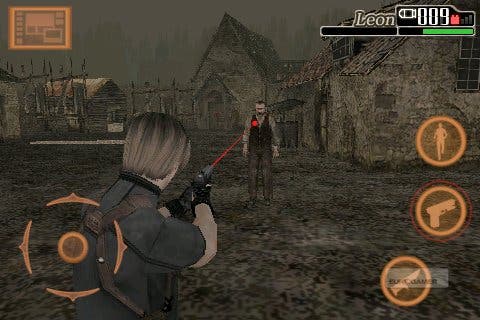Resident Evil 4: Mobile Edition
Tourist evil.
That's all the more striking when you consider the almost exact transposition of the controls. Hero Leon is manipulated with a virtual, analogue thumbstick in the bottom left, with buttons on the right switching between movement, aiming his gun with the familiar red laser sight and tight over-the-shoulder view, and using his knife. Contextual buttons also appear for picking up and using objects, kicking vulnerable enemies and so on. It's an efficient system, and the virtual stick works well enough for movement, although its sensitivity can be bizarrely and frustratingly unpredictable - and tracking painfully slow - when aiming.
Although the end result isn't too far removed from the console experience - and it certainly wouldn't be a Resident Evil game without a slow, deliberate, heart-in-mouth aiming system - Mobile Edition's combat edges over the boundary into the cheerless territory of "no fun". The wavering fudginess to taking aim and lack of feedback take most of the blame for that. It's not as if these are inherent flaws of touch-screen control, but past iPhone releases (including the aforementioned MGS Touch) have proven that using the whole screen as a track-pad provides more accuracy and tactile satisfaction, and good sound helps too. Apple's device is certainly capable of far better audio than the handful of weedy, coarsely compressed samples gracing this game.
Graphical fidelity is much better, and the 3D engine is smooth and capable by iPhone standards, with good draw distance. But the - admittedly remarkable - efforts made to transpose the original game assets onto the iPhone are misguided. Limited animation lets the models down, and limited resolution and texture definition mean that the original's moody look quickly becomes just muddy, with far-off enemies hard to make out in the overall murky wash of brown and grey.

There's only one difficulty setting, and it's a tough game, for some fair reasons and some unfair ones. The supply of ammo and health in each stage is meagre, and you'll need to spend money on these and upgrades between stages - with that gloriously overplayed Cockney weapons-dealer, a warmly-welcome old friend - to make consistent progress. You won't have much money, though, which is where Mercenaries mode comes in.
In Mobile Edition, the score-attack Mercs stages unlock one-for-one with the story stages as you progress. They re-use exactly the same maps and, as you'd expect, are a simple rush to kill as many enemies as possible within the time limit, with your score converting to cash at the end. They're an easy and useful way to earn currency, and arguably a more enjoyable way to play game in any case, although they go too far in turning the difficulty tables. Early Mercs maps in particular have you running in the same circles as the main game, only this time you're desperately hunting for a new spawn to kill, rather than racing to avoid them.
It would be tempting to say that Mercenaries mode saves Resident Evil 4: Mobile Edition, but all it really does is make it slightly less annoying. It's possible to have much more fun for much less money than its £4.99 price tag on the App Store. Capcom has made all the classic mistakes of the mobile port: over-developed technology, under-developed content, and an all-too-literal approach to the licence that doesn't tailor the design to the device. Yes, it's faithful - but it's blind faith.


